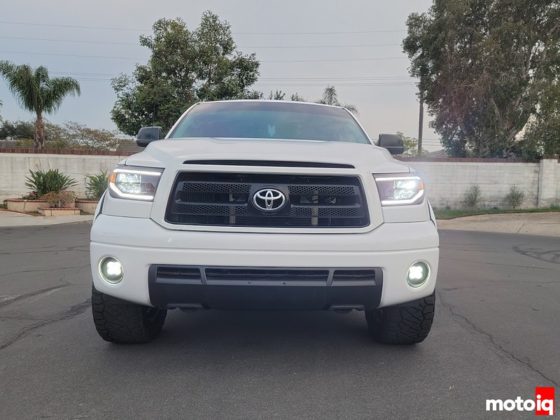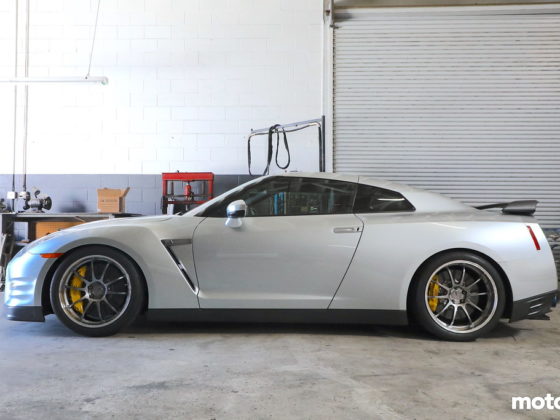 Attaching the line to the caliper with the supplied banjo bolt made this a quick and easy upgrade.
Attaching the line to the caliper with the supplied banjo bolt made this a quick and easy upgrade.
 The Viper uses a very common front Brembo caliper that has been used on the Ferrari F430, Lotus Esprit Turbo, Aston Martin Vanquish, and tons of others. Replacement pads range from $200-300.
The Viper uses a very common front Brembo caliper that has been used on the Ferrari F430, Lotus Esprit Turbo, Aston Martin Vanquish, and tons of others. Replacement pads range from $200-300.
After a bunch of research, we found that the front brake pad on our viper was the same as the rear brake pad on the 2003-2009 Cadillac CTS-V rear caliper, and this pad (part # 89047744) can be had for less than $90. Score!
 The factory Brembo pad was made by Galfer. The 3321GF pad was pretty aggressive and a great pad for the early 90’s. The CTS-V rear pad is a Ferodo HP1000, a pad similar to those used on the Ford GT500 and GT350 that I was involved in the development of, are fantastic pads, and a perfect match for the Ferodo DS2500 rear pads that we are using.
The factory Brembo pad was made by Galfer. The 3321GF pad was pretty aggressive and a great pad for the early 90’s. The CTS-V rear pad is a Ferodo HP1000, a pad similar to those used on the Ford GT500 and GT350 that I was involved in the development of, are fantastic pads, and a perfect match for the Ferodo DS2500 rear pads that we are using.
 Replacing the pads is as easy as removing the two pins, top sprung plate, compressing the pistons back into the caliper, pulling the pads out, and installing the new pads. The caliper does not need to be removed to change the pads out.
Replacing the pads is as easy as removing the two pins, top sprung plate, compressing the pistons back into the caliper, pulling the pads out, and installing the new pads. The caliper does not need to be removed to change the pads out.
 The Viper’s brake pressure distribution block does not seem to be a very good design. Pressure comes from the master cylinder and enters the distribution block from the top. Then the fluid goes straight through to the bottom line which goes to the left front tire, and the 90-degree port that comes out of the side of the distribution block goes to the right front tire. With a 50/50 corner balance, the Viper locks left front tires before the right front. I’m not sure if it’s due to the fluid having to make a 90-degree turn to go to the right front caliper, but it would be interesting to replace this with a “Y” block to see if it makes a difference.
The Viper’s brake pressure distribution block does not seem to be a very good design. Pressure comes from the master cylinder and enters the distribution block from the top. Then the fluid goes straight through to the bottom line which goes to the left front tire, and the 90-degree port that comes out of the side of the distribution block goes to the right front tire. With a 50/50 corner balance, the Viper locks left front tires before the right front. I’m not sure if it’s due to the fluid having to make a 90-degree turn to go to the right front caliper, but it would be interesting to replace this with a “Y” block to see if it makes a difference.
After bleeding the brakes and topping the fluid off with Castrol SRF, we were ready to bed in the brakes. After bedding in the brakes with multiple heat cycles, progressing the heat with each cycle, we were ready to push them to see how they perform.
CONCLUSION:
With the larger 40mm rear caliper and Ferodo pads front and rear, the Viper is now far less prone to locking the front tires, and the car decelerates noticeably better at the limit than before. On the street in most instances, the bias change isn’t noticeable, but when pushing the brakes aggressively, it’s pretty apparent the rear tires are contributing far more to the overall deceleration of the car. The Ferodo pads don’t have a ton of initial bite when cold, but after a hard stop or two, the friction level rises and the bite is greatly improved.
The Stoptech stainless steel lines and Castrol SRF really improved the brake pedal feel by reducing the sponginess and travel. Deceleration is determined primarily by the pressure you apply to the rock-hard pedal (like a race car) rather than the amount of travel of the pedal (which isn’t exactly true, but it’s a subjective feeling difference). This line and fluid combo are a must on any performance vehicle.
Overall, we were really happy with the improvements we made on the brakes, not only from a performance standpoint, but also from a safety standpoint. We look forward to testing these brakes on track to see how they hold up. Stay tuned for the next installment!
Quick Reference:
Page 1 – Stock rear brake caliper removal and measurements.
Page 2 – Rear 40mm calipers, stainless steel lines, and upgraded pads.
Page 3 – Replacing front brake lines with stainless steel.
Page 4 – Upgraded front brake pads and install.
SOURCES:
BILLY JOHNSON RACING
STOPTECH




1 comment
Where did you find the 40mm calipers?